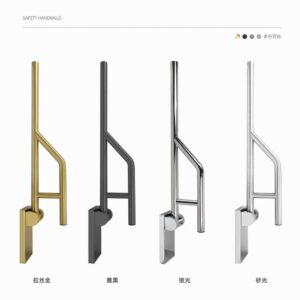Safety grab bars can be installed in two primary ways:
1, Screw-Mounted Installation: This method is the most secure and suitable for long-term use. It is important to ensure the screws are rust-resistant, but this method will damage the wall surface.
2, Suction-Mounted Installation: This method uses suction to attach the grab bar to the wall, avoiding wall damage. However, over time, the parts may wear out and fall off. Due to humid conditions, it is recommended to choose screw-mounted installation for better safety.
Three Factors to Consider When Choosing Safety Grab Bars
When choosing safety grab bars, it is essential to consider the user’s experience. The following three factors are crucial:
1, Comfort: Ensure the grab bar feels comfortable to grip, even when the user has weak or painful hands.
2, Distance Between the Grab Bar and the Mounting Surface: The distance should be sufficient to support a person’s full weight, ideally 4-7 cm.
3, Color Contrast: Ensure the grab bar contrasts with the mounting surface color, making it easy for visually impaired individuals to recognize it even in low light.
Different Installation Angles and Their Effects
1, Horizontal Installation: Suitable for transitioning from sitting to standing or vice versa, providing downward support and making it easier to use.
2, Angled Installation: For example, a 45° angle is ideal for transitioning from sitting to standing, helping distribute weight more evenly.
3, Vertical Installation: Suitable for those needing stable support, providing effective assistance for standing up.


Applications of Safety Grab Bars in Different Home Areas
1, Bathtub: Installing a grab bar next to the bathtub can help users stand up from the bathtub. It is recommended to use grab bars with a textured or non-slip surface.
2, Shower Area:
L-Shaped Grab Bar Installed Horizontally: Provides stable support inside the shower, preventing slips.
Straight Grab Bar Installed Vertically: Installed at the shower entrance to prevent slipping when entering or exiting.
3, Toilet:
Straight Grab Bar: Suitable for small bathrooms, installed at a 45° angle towards the front and upwards.
L-Shaped Grab Bar: Provides a larger support surface but requires enough wall space.
Foldable U-Shaped Grab Bar: Ideal for toilets not near walls, offering flexible support.
Fixed Floor-Mounted U-Shaped Grab Bar: Provides more stable support but occupies more space.
Floor-Mounted Toilet Chair: Suitable when there are no walls on either side and the rear wall cannot support a grab bar.
Doorways: Adding a vertical straight grab bar inside or outside the door can help elderly people enter and exit safely, preventing slips due to differences in floor height or material.
The Importance of Safety Grab Bars
Safety grab bars play a vital role in the lives of the elderly, the physically weak, and those recovering from injuries. They help these individuals complete daily activities and provide safety assurance. When selecting and installing safety grab bars, it is important to consider the material, installation method, and specific usage scenarios to ensure they provide optimal support and safety.
